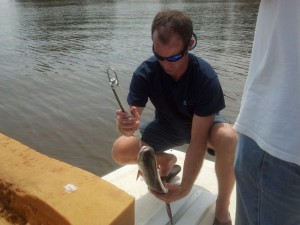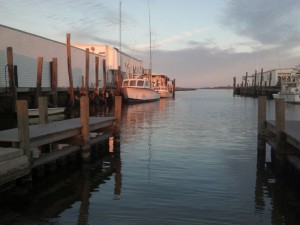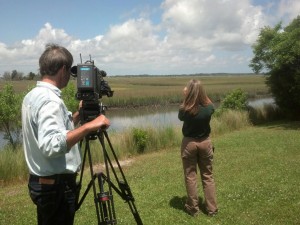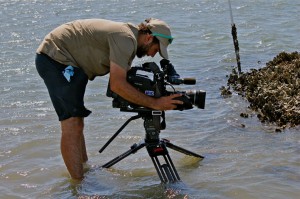By REBECCA NAGY
A red drum flops into the deck of a research boat as a team from the University of North Carolina at Chapel Hill frees it from a net. Waves of brackish water slosh up against the boat as sunshine glitters on the New River near Jackonsville.

Researchers from the UNC Institute of Marine Sciences study the connection between healthy habitat and a robust red drum population. Photo by Frank Graff.
If the fish is big enough, it will be tagged with a tracking device. Thus, researchers can learn where it swims and find out more about the habitat it needs. This catch-and-release may be an inconvenience to the fish, but it will yield important data.
Tracking the red drum’s movement helps researchers understand the best way to manage and maintain the fish’s population.
Thanks to expanded science coverage on UNC-TV, viewers now can witness meaningful
research taking place in North Carolina. This expansion — that includes special segments in statewide and national news programs — goes beyond traditional television broadcast to include a website where the videos are available, as well as information for teachers to bring the science stories into classrooms and to learners of all ages.
LOCAL STORIES
Since the first airing of North Carolina Science Now, viewers have trekked across the state tagging fish, searching for Lincoln, tracking storm surges and learning how to brew beer, all from the comfort of their own home.
A weekly segment within UNC-TV’s public affairs program, North Carolina Now, the Science Now stories give viewers a behind-the-scenes look at the science and the scientists.
Frank Graff, producer and reporter, and education specialist Lucy B. Laffitte collaborate on North Carolina Science Now to provide a comprehensive science lesson for the audience.
“I’m very pleased with the way Frank is approaching science,” Laffitte says. She notes that Graff’s innate curiosity for all things science, combined with his consummate story-telling ability, has been a great asset to the show.
UNC-TV turned to partners to enhance the program. Funding from GlaxoSmithKline enables Science Now to cross the state in search of compelling and educational science stories.
“By collaborating with people like North Carolina Sea Grant and the Museum of Natural Sciences, we are able to produce science content that could be delivered in a whole new way,” Graff adds.

Boats docked in a marina in Beaufort, near IMS and the Duke Marine Lab. Photo by Frank Graff.
Sea Grant has helped UNC-TV bring the researchers and their work to viewers. “We haveenjoyed various partnerships with UNC-TV over the years to help tell stories of coastal science,” notes Katie Mosher, Sea Grant communications director. “This is especially exciting because it is providing science content on a regular basis to wide audiences.”
Many of the programs focus on coastal science.
In the fish-tagging story, researchers from UNC-Chapel Hill’s Institute of Marine Sciences brought viewers to see how they conduct finfish research. The team caught, tagged and released red drum in an effort to track their movements and learn about important habitats. Additionally, UNC-TV consulted with researchers from NC State’s Center for Marine Sciences and Technology, who also use tags and tracking devices to study fish mortality.
A fishery management plan for the red drum, designated the state’s official saltwater fish, was first implemented in 1984. Regulations, approved by the N.C. Marine Fisheries Commission and based on research like that seen on the program, enabled the population of juvenile red drum to rebound. The N.C. Division of Marine Fisheries now lists red drum as recovering and the population of juvenile red drum as on the rise.
Not all of the programming is science in the traditional sense. In “Looking for Lincoln,” viewers meet Christopher Oakley, a professor at UNC Asheville, who is a former Disney animator and President Lincoln history buff. As Oakley works on a project to animate the Gettysburg Address, he realizes the man in a picture was not Lincoln as it was always thought. Through image modeling, Oakley discovers the real Lincoln in the crowd, uncovering a never-before-seen photo of the 16th president.
Some stories have even made it far beyond the borders of North Carolina and attracted national attention. “The one about amateur astronomers in Chapel Hill was picked up by NASA,” Graff recalls.
“The Real Star Power,” which features amateur astronomers taking part in the Staunton River Star Party, focuses not only on the science, but the people as well. While the program allows stars to shine, the people who conduct the science are not left in the dark.
One of the greatest successes of North Carolina Science Now has been its dedication to providing outreach to educators and students.
Along with each story that airs, UNCTV’s online science pages supply additional components that provide a comprehensive look at the science for students. The stories and related lessons are outlined to identify which N.C. Essential Science Standards and Next Generation Science Standards are covered. This allows teachers to incorporate the videos and lessons into their curriculum.

One program followed Sara Schweitzer, a coastal waterbird biologist with the N.C. Wildlife Resources Commission, who tracks egrets in the marshes near Beaufort. Photo by Frank Graff.
“The website is kind of like one-stop shopping and the videos are a good length for the classroom,” Graff says.
He provides a reporter’s blog with each story, allowing him to add a personal touch to his coverage of science stories.
“It’s also a way to report more information that simply can’t be included in the TV story, either because of length or the flow of the story,” he continues.
To ensure the integrity of the science presented, an advisory board of science and education professionals offers a technical review of the stories.
“The advisory board has been a huge help,” Graff says of the volunteer board, adding that the members help double-check the technical facts in each episode.
The journalists and advisors collaborate to make sure each week’s programming tells an accurate story. This is especially true of the episodes that discuss complicated science.
For Susan White, executive director of North Carolina Sea Grant, who serves on the advisory board, it is time well spent.
“This is a win-win partnership for Sea Grant and UNC-TV as we can brainstorm on ideas for content together — and consider opportunities for partnering to deliver stories about the science and these interesting characters in science,” White explains.
“The opportunities for teaching about the science and technologies explored across North Carolina are enormous and UNC-TV is an excellent, professional venue to deliver these stories.”
NATIONAL REACH
A national series called Quest also adds to the expanding science programming provided by UNCTV. As one of six public media stations that participates in Quest, UNC-TV is able to bring North Carolina stories in science, technology, engineering and mathematics — commonly called STEM — to a national audience. Funding for this season of Quest programming is provided by the National Science Foundation.

UNC-TV videographer Peter Bell wades into Middle Marsh to get some close-ups of oysters. Photo by David Huppert.
“Quest is a multiplatform science and education series with collaborators from public media stations throughout the country,” says David Huppert, producer for Quest North Carolina. He aims to create compelling and educational multimedia STEM content for different audiences.
Laffitte, also the education manager for Quest, manages six education staff members at six stations across the country. She orchestrates the content for the education page, which includes correlating Web posts to education standards, and designing, producing, testing and piloting videos, animations and games.
Quest also seeks input from local partners, such as Sea Grant. “We work with Sea Grant to identify compelling stories, characters and issues relevant to North Carolinians, as well as our national audience,” Huppert notes.
Sea Grant’s Mosher agrees. “We are pleased to have the opportunity to suggest stories from research teams at a wide range of universities, as well as community and agency partners.”
The episode on restoring oyster reefs, which aired last fall, featured Sea Grant-funded researchers using laser-scanning technology to determine the best locations for oyster beds.
Oysters are a vital part of the marsh ecosystem. They filter water and provide habitat for other organisms, including other oysters.
That program also focused on fishermen and conservationists who use bags of oyster shells to break up wave energy and protect the shores of Beacon Island from erosion. The bags also provide habitat for oysters.
There are still many more local science stories to tell. “We haven’t even scratched the surface on all the great science going on in North Carolina,” Huppert says. “In the future, I’d like to focus on some of the innovators the president alluded to when he named Raleigh the next high-tech hub.”
He is referring to the Next Generation Power Electronics Innovation Institute at NC State. President Barack Obama launched this $140 million initiative, which is partly funded by the Department of Energy, in January. The institute will unite academic, government and industry partners to focus on energy efficiency.
With many stories already completed and more in the works, the individuals who create North Carolina Science Now and Quest have a major goal in mind — sharing the mystery and wonder of science.
“I want viewers to leave with a sense of, ‘Wow! That’s cool!’” Graff says.
North Carolina Science Now airs every Wednesday during North Carolina Now at 7:30 p.m. on UNC-TV. Past segments and additional information can be found at science.unctv.org/content/ncsciencenow. The next Science Now story will air in April.
All national Quest programs can be found at science.kqed.org/quest/. Quest North Carolina can be found at science.kqed.org/quest/stations/north-carolina/. Check your local listings for Quest programming.
This article was published in the Spring 2014 issue of Coastwatch.
For contact information and reprint requests, visit ncseagrant.ncsu.edu/coastwatch/contact/.
